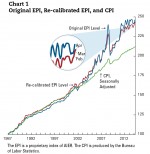Everyday Prices are Mixed in April
The EPI measures the prices of goods and services purchased on an everyday basis. It is designed to reflect an average household’s day-to-day inflation by tracking prices of frequent purchases. Although food and energy make up a large share of household budgets, consumers also felt price changes in recreation and healthcare. The price of seeing a concert (+0.7 percent) and taking lessons (+0.1 percent) both increased in April. Prices at the pharmacist were higher led by prescription drugs (+0.2 percent) and personal care products (+0.1 percent). Consumers experienced a slight relief from higher prices, club fees and dues were flat and mailing letters and packages dipped 0.1.
Looking back over the past 12 months the EPI has increased 2.2 percent, slightly greater than the 2.0 percent increase in the CPI. Year-over-year, trips to the gas pump (+2.5 percent) have squeezed daily budgets while putting food on the table (+1.7 percent) has crowded out other expenditures. Although everyday prices have outpaced the overall CPI, inflation remains subdued. Check back next week for AIER’s upcoming Inflation Report which explores the forces restraining inflation and the outlook for the U.S. dollar.
About the EPI
AIER’s Everyday Price Index (EPI) is designed to reflect the price changes felt by consumers on a day-to-day basis. The EPI includes goods and services from the Consumer Price Index (CPI) that are purchased on a monthly basis. For example, the EPI includes food, gasoline, utilities, prescription drugs, and telephone services. On the other hand, the EPI does not include infrequent expenditures such as housing, cars, appliances, and apparel.
As of May 2014 the EPI was revised to account for monthly changes in the relative importance of expenditures. Changes in relative importance do not reflect change in consumer preferences. Instead changes in relative importance reflect how price changes affect household budgets. Click here for the complete updated EPI methodology.





